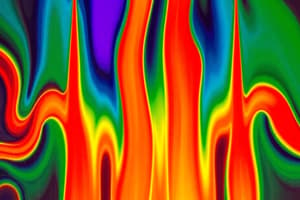Podcast
Questions and Answers
What is the primary direction of heat flow?
What is the primary direction of heat flow?
- From lower to higher temperature
- From left to right
- From higher to lower temperature (correct)
- From top to bottom
What is the primary focus of heat transfer study?
What is the primary focus of heat transfer study?
- Temperature variation in a vacuum
- Heat transfer in a perfectly insulated system
- Equilibrium states of a system
- Rate of energy transfer under specified conditions (correct)
Which of the following is an example of a non-equilibrium phenomenon?
Which of the following is an example of a non-equilibrium phenomenon?
- Heat transfer in a cooling system
- Heat transfer in a non-equilibrium system (correct)
- Heat transfer in a thermodynamic system
- Heat transfer in an equilibrium state
What is the primary purpose of designing heat exchangers?
What is the primary purpose of designing heat exchangers?
What is the primary concern in heat transfer problems in practice?
What is the primary concern in heat transfer problems in practice?
What are the three modes of heat transfer?
What are the three modes of heat transfer?
In which of the following situations is heat transfer involved?
In which of the following situations is heat transfer involved?
What is the primary focus of heat transfer applications in human comfort?
What is the primary focus of heat transfer applications in human comfort?
What is the primary mechanism of conduction heat transfer in liquids and gases?
What is the primary mechanism of conduction heat transfer in liquids and gases?
What is the main reason for the difference in conduction heat transfer between gases and liquids?
What is the main reason for the difference in conduction heat transfer between gases and liquids?
What is the unit of thermal conductivity (k) in Fourier's law?
What is the unit of thermal conductivity (k) in Fourier's law?
What is the assumption in Fourier's law regarding the temperature profile?
What is the assumption in Fourier's law regarding the temperature profile?
What is the primary cause of natural convection heat transfer?
What is the primary cause of natural convection heat transfer?
What is the direction of heat exchange in all three modes of heat transfer?
What is the direction of heat exchange in all three modes of heat transfer?
What is the unit of the heat transfer coefficient h?
What is the unit of the heat transfer coefficient h?
What is the condition required for the application of Fourier's law?
What is the condition required for the application of Fourier's law?
What type of convection occurs when the fluid motion is initiated by external means?
What type of convection occurs when the fluid motion is initiated by external means?
What is the term for the movement of free electrons in solids that contributes to conduction heat transfer?
What is the term for the movement of free electrons in solids that contributes to conduction heat transfer?
What is the purpose of Newton's law of cooling?
What is the purpose of Newton's law of cooling?
What is the physical quantity represented by the symbol 'Q' in Fourier's law?
What is the physical quantity represented by the symbol 'Q' in Fourier's law?
What is the thermal conductivity of lubricating oil, SAE 50?
What is the thermal conductivity of lubricating oil, SAE 50?
What is the heat transfer rate by convection represented by in Newton's law of cooling?
What is the heat transfer rate by convection represented by in Newton's law of cooling?
What is the fluid property that affects the convection heat transfer coefficient?
What is the fluid property that affects the convection heat transfer coefficient?
What is the nature of fluid flow that occurs due to buoyancy effects?
What is the nature of fluid flow that occurs due to buoyancy effects?
What is the minimum temperature at which a body radiates heat?
What is the minimum temperature at which a body radiates heat?
What is the term for the rate at which energy is released per unit area?
What is the term for the rate at which energy is released per unit area?
What is the upper limit to the emissive power prescribed by?
What is the upper limit to the emissive power prescribed by?
What is the term for a surface that emits energy at the maximum possible rate?
What is the term for a surface that emits energy at the maximum possible rate?
What is the value of the Stefan-Boltzmann constant?
What is the value of the Stefan-Boltzmann constant?
What is the range of values for the emissivity of a real surface?
What is the range of values for the emissivity of a real surface?
What is the formula for the net radiation heat transfer between a surface and its surroundings?
What is the formula for the net radiation heat transfer between a surface and its surroundings?
What is the term for the radiative property of a surface that provides a measure of how efficiently it emits energy?
What is the term for the radiative property of a surface that provides a measure of how efficiently it emits energy?
What is the primary factor affecting the thermal conductivity of a material?
What is the primary factor affecting the thermal conductivity of a material?
Which of the following materials has the highest thermal conductivity at 0°C?
Which of the following materials has the highest thermal conductivity at 0°C?
What is the effect of impurities on the thermal conductivity of metals?
What is the effect of impurities on the thermal conductivity of metals?
Which of the following materials has a lower thermal conductivity than copper?
Which of the following materials has a lower thermal conductivity than copper?
What is the primary reason for the difference in thermal conductivity between metals and non-metals?
What is the primary reason for the difference in thermal conductivity between metals and non-metals?
What is the unit of thermal conductivity (k) in Fourier's law?
What is the unit of thermal conductivity (k) in Fourier's law?
Flashcards are hidden until you start studying
Study Notes
Heat Transfer Fundamentals
- Heat flows in the direction of decreasing temperature
- Heat transfer study concerns the mode of heat transfer, rate of energy transfer, and temperature variation in a medium
- Thermodynamics deals with equilibrium states, while heat transfer is a non-equilibrium phenomenon
Areas of Practical Engineering Applications
- Design of heat exchangers (e.g., radiators, condensers)
- Heat treatment of metals
- Human comfort
- Refrigeration and air-conditioning units
- Rating and sizing of heat transfer systems
Modes of Heat Transfer
- Three modes of heat transfer: conduction, convection, and radiation
- Each mode has a distinctive controlling law
- Heat transfer occurs in the direction of lower temperature
Heat Transfer by Conduction
- Conduction heat transfer occurs in a stationary medium (solid or fluid)
- Energy exchange is due to atomic or molecular activity in the presence of a temperature difference
- In solids, heat transfer is a combination of lattice vibrations and free movement of electrons
- In liquids and gases, conduction is primarily by collisions and diffusion of molecules
Fourier's Law of Conduction
- The rate of conduction heat transfer is given by Fourier's law (Eq. 1)
- 𝑄 = heat transfer rate by conduction (W), A = area (m2), k = thermal conductivity (W/m.℃), 𝑑𝑇/𝑑𝑥 = temperature gradient (℃/m)
- Assumptions: steady-state conditions, one-dimensional heat flow, no internal heat generation, and constant temperature gradient
Thermal Conductivity, k
- Materials are classified as thermal conductors or insulators based on their thermal conductivity
- Thermal conductivity depends on material structure, moisture content, material density, pressure, and temperature
- Generally, thermal conductivities for pure metals are the highest, but decrease with the inclusion of impurities
Heat Transfer by Convection
- Convection heat transfer occurs as a result of bulk fluid motion over a surface at a different temperature
- Convection heat transfer is categorized into natural (free) and forced convection
- Natural convection is induced by buoyancy effects, while forced convection occurs when the fluid motion is initiated by external means
Newton's Law of Cooling
- The rate of convection heat transfer is defined by Newton's law of cooling (Eq. 2)
- 𝑄 = heat transfer rate by convection (W), A = area (m2), h = heat transfer coefficient (W/m².℃), Ts = surface temperature, 𝑇∞ = fluid temperature
- The convection heat transfer coefficient, h, depends on fluid properties, nature of fluid flow, and surface geometry
Heat Transfer by Radiation
- Thermal radiation is energy emitted by matter at finite temperature
- All bodies at temperatures above absolute zero radiate heat
- Radiation energy is transported by electromagnetic waves (or photons)
- Radiation heat transfer occurs efficiently in a vacuum
Stefan-Boltzmann Law
- The rate at which energy is released per unit area (W/m²) is termed the surface emissive power, E
- The maximum radiation heat transfer from a surface (blackbody) is defined by the Stefan-Boltzmann law (Eq. 3)
- 𝑄 = heat transfer rate by radiation (W), A = area (m2), 𝜎 = Stefan-Boltzmann constant (W/m².K⁴), Ts = surface temperature (K), 𝜀 = emissivity (0 ≤ 𝜀 ≤ 1)
Studying That Suits You
Use AI to generate personalized quizzes and flashcards to suit your learning preferences.



